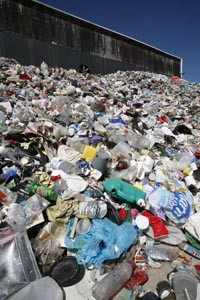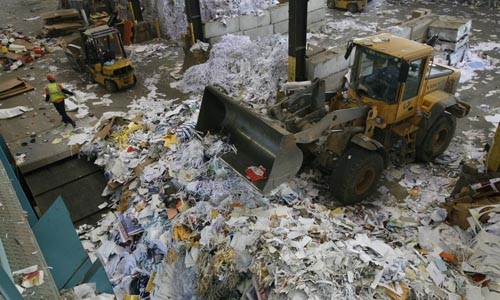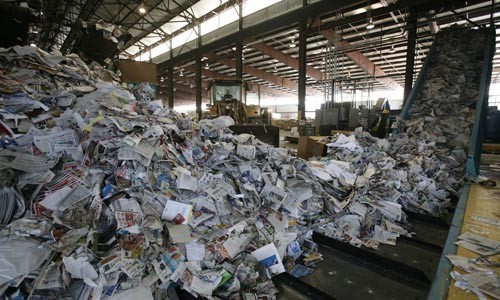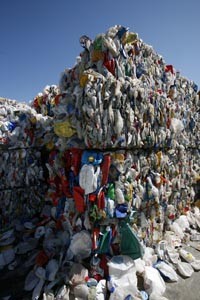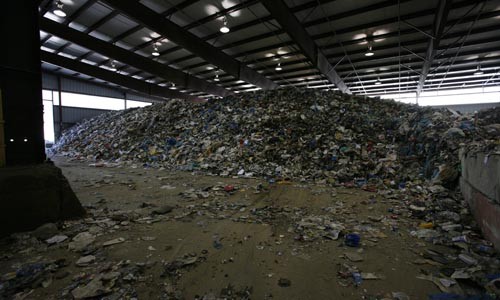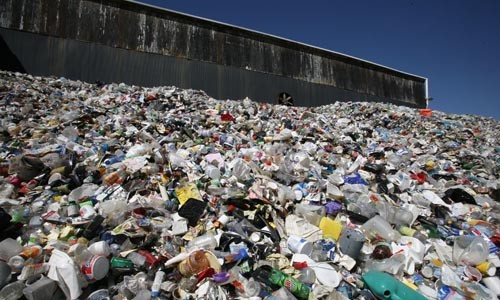On a Saturday morning, at the City of Pittsburgh's recycling drop-off site in Point Breeze, you're among the recycling bins and the true believers. The 15 dark-blue, office-cubicle-sized metal containers border the parking lot of Construction Junction, an outlet for used construction materials. Daily the cars stream in, and drivers unload the cardboard boxes, junk mail and phone books, the glass and plastic containers they've accumulated at home.
None of them has to do it: Pittsburgh residents have curbside "blue-bag" pickup, so many drop-off patrons are contributing materials the city doesn't yet mandate in their neighborhoods. Some recyclers don't even live in the city. On a recent Saturday, Rusty Chapman, a silver-haired Churchill resident, delivered four plastic bags of plastic bottles, a box of paper, a box of paperboard. She makes a similar run "at least every other week," she says.
"I'm a green person," says Chapman. She shops at farmers' markets and house sales. At home, she cleans with natural products; at the office, she gathers old phone books to recycle. She cuts her lawn with a pushmower. "Everyone on the street has landscapers. They think I'm crazy."
People like Chapman -- those intent on keeping resources out of landfills -- are the backbone of any recycling program, and Pittsburgh's is showing new signs of life. This year, its Public Works department increased the number of materials its blue recycling trucks collect in two of five collection areas, adding cardboard, junk mail and other kinds of paper. Through March, tonnage had risen more dramatically than in the 16 years since the city, under state mandate, added newsprint to the list of recyclables.
Including material from drop-off centers like Point Breeze's -- by far the city's busiest, with its bins filled to overflowing daily -- Pittsburgh's recyclables haul last year was 13,300 tons, or about 13 percent of the city's household garbage. That's well below the national average of 33 percent. But with the new collections set to expand citywide this year -- and community initiatives to increase participation -- recycling coordinator Sean Wigle says Pittsburgh can double its rate by the end of 2009.
Even better, the economics of curbside recycling have cycled Pittsburgh's way. For years, going green meant red ink: It was cheaper to dump garbage in a landfill than to process it for recycling. But with landfill fees rising, the difference between recycling a ton and burying it is $70. In 1992, Pittsburgh paid $31.61 to process a ton of recyclables; now the city earns for $46.46 a ton from its leading purchaser. It's still not a break-even game -- state funds subsidize about half of the city's $1 million-plus program -- but it's headed in the right direction.
In the 20 years since Pennsylvania mandated curbside collection for municipalities of 5,000 or more, separating recyclables has become most people's front door to environmentalism: the most hands-on way we can save the planet.
Yet for many of us it's the back door, too: a way to do good that's all too easy, and that leaves our massive consumption of resources all but unabated. For years, environmentalists have told us to first reduce consumption, then to reuse what we buy, and only then to recycle. But somehow, the option of last resort became the default setting.
Leading environmental thinkers say it's time to take a different approach to our economy -- which means cultivating an even more radical relationship to the resources we use. And even true believers like Rusty Chapman know their hands aren't all green.
"Of course here I am driving this that uses too much gas," Chapman admits, indicating her white Kia minivan, with its "One Planet, One Future" bumper-sticker. "But how could I carry all this stuff," she jokes, "if I downsized to a little car?"
Where It All Goes
Recycling household waste begins when you sort it, but it doesn't end until someone turns it all into something someone wants. For Pittsburgh, the main middle-man is Recycle Management, a company whose Strip District transfer station receives all those blue bags and loads them on trucks headed for its facility on Neville Island.
Visiting that plant, though, makes you realize that for all its good work, it's also part of society's consumption machine.
Neville Island itself greets you with a sulfur smell: The island's upstream end is lined with the gates of the Shenango coke works, Cemex, Neville Chemical and Calgon Carbon Corp. Recycle Management (owned by Houston-based recycling giant Greenstar) sits on 16 acres, the former site of a detinning plant, with a warehouse-like new processing building set to open June 1. The plant employs about 80. Workers go around the clock five days a week, taking in about 10,000 tons a month from municipalities, businesses, hospitals and colleges.
Amid the white noise of machinery, trucks dump recyclables into a hopper, and a conveyor belt carries them past workers wearing gloves and safety goggles who remove unrecyclable materials -- computers, lawn chairs, plastic bags. "It's amazing what some people think they can recycle," says Frank Stasik, the plant's materials manager. "We actually had four deer come up."
A second conveyor, composed of rotating plastic wheels of progressively smaller size, lets containers drop into supplementary lines, where magnets separate ferrous metals (like tin cans) from the aluminum, and a high-tech machine sorts plastic containers. Newspapers and cardboard continue to line's end, where workers do a final sort. Big hydraulic machines compact and bale everything for shipping to buyers. Most departs by truck, the newsprint via railcars sitting right outside the door.
Forklifts scoot around the 6-foot-long bales of crushed aluminum cans, 850 pounds each and stacked three high. Nearby, a bale of paper blooms with glossy color campaign flyers. ("See if YOU agree with Matt Shaner on ... IMMIGRATION.")
"A lot of people think it's garbage, but you look at it, it's money," says Stasik. "It makes sense. It's good PR," he adds of recycling. "Morally it makes sense also."
Watching stuff move up the processing line, his back to a 20-foot-tall mound of backlogged material, Stasik says, "That's the goal -- to feed the monster."
Recyclables are commodities, after all. In the early 1990s, when curbside programs were gearing up nationally, there was a glut: lots of new supply and limited processing capacity. Now, although some materials are much more valuable than others, collectively recycling is a profitable business.
One March day, for example, aluminum was going for 95 cents a pound -- double the price five years ago. The price of volatile commodities like aluminum "fluctuates literally every five minutes," says Tom Jackson, the plant's operations manager. "It's like the stock market."
Steel prices benefit too, says Bob Garino, director of commodities for the Washington, D.C.-based trade group Institute of Scrap Recycling Industries, Inc. One grade of scrap, called No. 1 heavy melt, was $65 a ton in late 2001; today, Garino says, it's headed "well over $400. ... It's just been amazing." And in gauging future demand for scrap, Garino sees "very little in the way of let-up for some time to come."
Indeed, half our steel and more than a third of our paper products is recycled content. Even plastic sells -- 21 cents a pound for old polyethylene soda bottles, for example.
It seems implausible that something so light and cheap as plastic is valuable, especially when you see how Recycle Management sorts it. The company's brand-new state-of-the-art optical-sorting system -- a three-story array of five machines, each costing at least $400,000 -- employs cameras to identify bottles by resin and color, then uses puffs of air to send the desired containers vaulting into a bin, like a stunt bikers off a cliff. The machines' motors shake the assembly's raised metal walkways as crumpled quart iced-tea bottles zip by on the 5-foot-wide belt, scattered so as not to confound the sensors.
"Plastic makes us money," says Jackson. The only unprofitable commodity is glass, which Recycle Management pays a local glass recycler to haul away. Glass "takes up a lot of the weight and a lot of the volume and it's not a lot of value when it's processed," says Jackson. "When Anheuser-Busch and Iron City started making aluminum beer bottles, we were jumping for joy."

The recycling market is global. The No. 1 U.S. export commodity is now recovered paper, with more than 6 billion metric tons a year bound for fast-growing, deforested China alone. Indeed, unbridled -- and environmentally disastrous -- growth abroad is the big reason recycling pays so well at home.
Or as the Recycling Association of Minnesota Web site puts it: "The Chinese economy is buying up anywhere from a quarter to a third of our recyclable materials to feed their rapid economic growth. This situation is creating competition for your stuff -- so keep it coming!"
Stuff Happens
America's manufacturing base has eroded, but when it comes to consumption, we still bring it. And though we're recycling more than ever since the wartime thriftiness of World War II, the benefit is, at best, relatively small.
Most of us recycle to help the environment, and we might be succeeding. Thanks largely to some 8,700 curbside-recycling programs, says the EPA, Americans now recycle about one-third of our household trash. In Pittsburgh alone, when the city added paperboard to its recycling drop-off centers, cardboard collection climbed some 25 percent, to 280,000 pounds. Recovered tonnage of magazines, catalogs and paperboard jumped nearly 50 percent. Because of efforts like this across the country, we're filling up dump sites no more quickly today than we did in 1990, despite our increased population and consumption.
But put those numbers in some perspective. In 2006, most things consumers might personally recycle were part of a household-waste stream totaling 250 million tons nationwide. That works out to about 4.5 pounds of trash daily for you, the average American. On that very same day, Average American, by contrast, the economy will produce about 140 pounds of resources on your behalf, the overwhelming majority of which can't be recycled.
Nearly half of that is your share of the three billion or so tons of sand, stone and gravel we dig up for use in roads and buildings each year. Another one-third is fuel, mostly of the fossil variety. Your daily per-capita total, according to 2000 statistics compiled by the World Resources Institute, also includes about 19 pounds of agricultural products (mostly food and animal feed) and a few pounds of metals and minerals, paper and forest products, glass, plastics and the like.
For many materials in our national waste stream, household trash is just the tip of the iceberg -- the only part the average person can grab. According to the EPA, household garbage might be as little as 55 percent of municipal solid waste. Much of the rest comes from sources like construction or demolition debris, or stuff that schools and hospitals throw out. Most recyclable paper products flow through the workplace, where neither consumers nor workers have much influence over what actually gets recycled.
Then there's the stuff that you never get to recycle because it's wasted in the process of creating the stuff you put in the blue plastic bag. To capture coal, petroleum and other subterranean goodies, hundreds more pounds per person of rock, mine tailings, earth, animal and plant life and water are moved or contaminated. The waste -- everything that's dug, pumped, shifted or burnt -- exceeds 500 tons a year for each of us. That's about 20 times what you actually use each day. And these figures don't even include waste generated overseas for goods exported here for your use.
Moreover, our trash has grown increasingly complex. A century ago, waste was wood and clay, cotton and wool, glass, leather, a few metals. With synthetics came disposable shoes and disposable diapers. Now we've got squadrons of home appliances -- in particular, electronics, a rapidly growing and especially troubling part of the waste stream. Manufacturing computers and cell phones, all plastic and metal, causes all kinds of environmental mayhem. Plus they go obsolete rapidly, and they're so painstaking to disassemble that fewer than 20 percent of personal computers are recycled. And even when they are, the work is often carried out in developing nations, where lead, mercury and burning plastic poison unprotected workers and foul air and water.
Above all, there's energy. Most of the energy consumers use -- and hence their biggest impact on climate change -- can never be recycled. We burn it up driving cars, heating houses, keeping the milk cold. Annually we burn a billion tons of coal (mostly for electricity), and refine about twice that tonnage of petroleum (mostly for transportation).
And what good is it to fret over a polystyrene clamshell when the hamburger inside ate up so many times more resources? Recycling does little to change how we heat or light our homes and businesses, grow our food, or get from place to place. To focus on recycling may be like fixing a leaky faucet after the reservoir's burst.
At the least, as Robert Lilienfeld and garbage expert William Rathje put it in Use Less Stuff, their 1998 primer on enviro-thrift: "We may be asking more of recycling than it can possibly achieve."
What Are We Recycling For?
Certain types of recycling do help the planet, says Lester Lave, a Carnegie Mellon University economics professor who studies environmental issues. But a diesel-reliant, door-to-door pickup system like Pittsburgh's "more than completely cancels" the environmental benefits of the program, says Lave. The energy used to pick up the recycling "puts you into the negative category."
In a 1999 study for the EPA, Lave and his co-authors wrote that "for most communities, curbside recycling is justifiable only for some post-consumer waste, such as aluminum and other metals." In terms of the resources needed to create them, environmentally it just doesn't pay to pick up things like plastic, most paper and, especially, glass.
Recycling's most direct impact is to keep stuff out of landfills. But while dumps are an unpleasant reality, they aren't among our worst environmental problems. With ice caps melting, glaciers shrinking and coastline disappearing, we have far bigger worries than buried trash.
"The definition of recycling distracts society from the real issues: environmental quality and sustainability," says the study.
Chris Hendrickson, a CMU engineering professor who co-authored that study, specializes in life-cycle analyses -- the study of a given item's total environmental impact from manufacture to disposal. How does he rank household-waste recycling in environmental importance? Excepting toxic stuff, like batteries, and resource-intensive metals, "I'd put it pretty low," he says. "I'd be much happier if people started walking to stores." Landfills don't bother him, either: "I'm of the opinion that eventually landfills will be mined. I just look at them as a storage area."
Lave and Hendrickson are in the minority. Numerous studies suggest recycling conserves energy because reusing a material that's already been processed from virgin minerals, wood and petroleum is easier than creating it from scratch. A 2006 report by Danish experts, commissioned by U.K.-based Waste & Resources Action Programme, concluded, "Most studies show that recycling offers more environmental benefits and lower environmental impacts than other waste-management options," including for greenhouse gasses. The EPA estimates that the 82 million tons of municipal waste we recycled in 2006 reduced carbon emissions by 49.7 million metric tons -- an amount the agency says is "comparable to removing 39.4 million passenger cars from the road each year."
But of course, recycling didn't spirit nearly every third car from American roads. At best, recycling slows our ravages without curbing our appetites. Paper and plastic, the vast majority of our manmade household waste, have only so many recycling lives before they break down. And often they're "downcycled" into something much less valuable than their original use (like turning pop bottles into carpeting). In the words of visionary green designer William McDonough, recycling is just a way to be "less bad."
No one solution can fix all our environmental problems, of course. But recycling isn't like growing your own food, or trading your car for a bike. While it would take thousands of such individual decisions to make much difference, none of them would hurt. By contrast, recycling works by the same logic as the market whose excesses it's meant to alleviate: Cheap fuel keeps it affordable to run the trucks that carry recyclables and the machines that process them, and economic growth keeps prices high. To some critics, recycling as we know it looks like just another way industrial society does things dumb.
Our economy doesn't just promote consumption; it absolutely requires it. The most common measure of our economic health, gross domestic product, summarizes all the money we spend, most of it directly reflecting materials processed and energy burnt. Even with today's fevered awareness of global warming, when recession strikes, watch how quickly talk of smaller carbon footprints gives way to growth schemes.
Moreover, it's easy for industry to co-opt people's enthusiasm for environmental friendliness. Even car ads these days are full of bright green leaves and pristine drops of water. Or consider the claim made in Alcoa press materials that because making products from recycled aluminum uses 95 percent less energy than using virgin material, "Aluminum recycling is part of the clean air solution." It's buy-more-and-save logic: Presumably, if we used twice as much aluminum, and recycled the same percentage, the air around aluminum plants would get twice as clean.
Green marketing, says Earth Policy Institute director of research Janet Larsen, "sends the message that you can keep your high-consumption lifestyle and save the planet at the same time."
For corporations (which already routinely recycle their in-house scrap), curbside recycling is a deal. Industry, we're told, relies on recycled materials: Half our steel and more than a third of our paper products is recycled content, some of it thoughtfully sorted by citizens and picked up with the help of government subsidies. Corporations get tax-subsidized materials and a green reputation, all while pushing more consumption.
But with 5 percent of the world's population, Americans use about 25 percent of its resources. "We're simply profligate in our use of energy," says CMU's Lave. We could double our recycling rate and still do massive environmental damage just by lighting our bulbs, running our electronics, heating and cooling our homes, and driving our cars alone.
So would the millions spent on recycling programs -- Pennsylvania's DEP alone spends $20 million a year -- be better spent on improving public transit, or getting people to insulate their houses, or developing renewable energy? Theoretically, of course, we could improve on all fronts. But the funds needed to do so are scarce.
We know what saves the most resources: Reduce first, reuse second, recycle only when all else fails. We could turn off lights and turn down thermostats, insulate, install solar panels, move into smaller houses. We could relocate to neighborhoods that let us walk to work. Insist that government invest in public transit rather than highways. Eat less meat.
But mostly, we don't. Because it would be hard. Because it would be ... impossible. So instead, we put some of our trash in a blue bag, and let someone take it away. It's the difference between an easy thing whose benefits (however small) we can see and a hard thing whose destructiveness (however large) we can't.
The 1990s, the first decade of large-scale curbside recycling in the U.S., was also the decade of ever-bigger houses on lots bulldozed ever farther from urban cores, filled with growing arrays of energy-sucking electronics and commuted from by SUV. What do we say about an environmental mindset that scrupulously recycles its sports sections while building pleasuredomes for ice hockey in Phoenix?
We might improve our recycling systems. Lave, for instance, suggests European-style drop-off points at places people already frequent, like supermarkets; what it sacrificed in convenience (and probably participation) it would save in collection costs.
But still, recycling would change us little. Our whole economy is predicated on mugging Mother Nature; recycling merely reinvests the contents of the old lady's wallet.
Coming Full Circle
Experts agree that the planet is dangerously overtaxed. The leading edge of environmental thought suggests that for things to change fast enough to prevent environmental collapse, we need to rethink how our manmade environment affects the natural one.
The free market is all too free with such gifts as disappearing rainforests, depleted aquifers, killer agricultural runoff, mine tailings and airborne toxins. Economists call such things "externalities": Nobody pays for them because everyone does, one way or another. The carbon emissions chiefly responsible for human-caused climate change are only the best-known example.
And because no one pays for these problems -- because they're the result of billions of individual economic decisions we make, or are made for us, each day -- the solution won't be found by placing the burden solely on conscientious consumers. Government will need to take the lead, with reducing and reusing in mind as much as recycling.
One small way is to just say "no" to obvious waste, as in Ireland's ban on plastic shopping bags, or San Francisco's recent end to city purchases of bottled water. Meanwhile, recovery of hard-to-recycle products, like electronics, can be boosted by programs like those that require many European and Japanese companies to take back their wares when consumers are done with them.
On an industrial scale, experts propose internalizing the externalities: making a product's price reflect the true environmental cost of its manufacture and transport. "We need to get the price right," says Lester Lave, the CMU economics professor.
A big first step would be to cut subsidies for ecologically harmful activities like driving cars (through highway construction) and for industries like logging and oil drilling. Germany cut subsidies for its coal industry before becoming No. 1 in wind power in Europe.
We also need a scheme to limit carbon emissions. Corporations tend to favor a cap-and-trade system, like the kind the U.S. used to slash power-plant sulfur emissions in the 1990s; economists prefer a tax, because it's bureaucratically simpler and harder for polluters to avoid.
Lester Brown, the environmental thinker who heads the Earth Policy Institute, wants to reduce global carbon emissions 80 percent by 2020. To do so, he proposes gradually shifting the tax burden from labor to carbon emissions. In the U.S., he proposes replacing the income tax with a tax of $240 per ton of carbon emitted, phased in over 12 years. In books like his new Plan B 3.0, Brown argues that, combined with investments in efficiency and in renewable energy, this would both create jobs and help the environment.
A per-ton tax of $240 would add about $5 to a gallon of gas and significantly raise the price of nearly everything. But tax policies could be crafted to relieve the burden of higher prices on the poor, and researchers say versions of such taxes have already reduced fuel use after being imposed throughout Europe.
In Denmark, carbon emissions dropped by 15 percent from 1990-2005 -- in the U.S. during the same period, they rose 18 percent -- while renewable energy's share of the market rose from 3 percent to 25 percent. CMU's Lave, too, looks to Denmark, where despite a comparable lifestyle, energy use per capita is half of ours, both because of efficiency (like triple-paned windows) and lifestyle (Danes live more densely and drive a lot less).
Other thinkers tout radical efficiency. In their 1998 book Natural Capitalism: Creating the Next Industrial Revolution, Paul Hawken, Amory Lovins and Hunter Lovins note that we're bedeviled by technologies like the internal-combustion automobile, only 1 percent of whose energy expenditure is used to actually transport the driver. Citing the early 1980s, when the U.S. economy grew alongside the efficiencies the 1970s oil crisis ushered in, they say we can grow while cutting carbon emissions, too. Were our economy remade sustainably, they estimate, good engineering and high-tech materials could stretch our resources from 10 to 100 times further.
William McDonough and Michael Braungart, meanwhile, reject efficiency as a dangerous relic of the industrial age -- one that merely slows the poisoning of the planet and the inevitable disappearance of nonrenewable resources. ("It will let industry finish off everything, quietly, persistently and completely.") In their widely cited 2002 book Cradle to Cradle, architect McDonough and Braungart, a chemist and activist, propose redesigning the entire built world, from buildings to shoes, to mimic nature's "closed-loop" cycles, in which waste does not exist. Boasting successes with major companies -- Herman Miller furniture, Shaw Carpets -- they propose designing all products with either endless recycling or biodegradability in mind.
Other paradigm shifts: Let's stop looking at "human health" and "the environment" as separate categories, as though a sick world could support healthy people. And consider the work of environmental writer Bill McKibben, whose 2007 book Deep Economy proposes learning to value durability and community over disposability and raw growth -- and moving to more locally based economies as a way to promote them while conserving resources.
We might also explore ways to measure society's success other than gross domestic product -- which counts an oil spill as "productive" because of the jobs and economic activity created by cleaning it up. In 1995, the think tank Redefining Progress created one such model: the Genuine Progress Indicator. The GPI looks at both sides of the economic ledger, crediting jobs but subtracting the costs of pollution and depletion of resources.
What does all this have to do with recycling? Just a little. And maybe that's the point.

